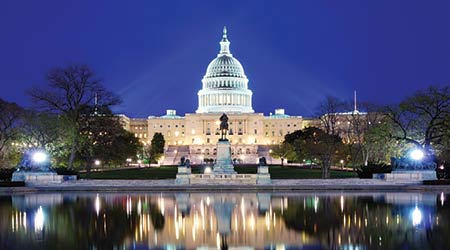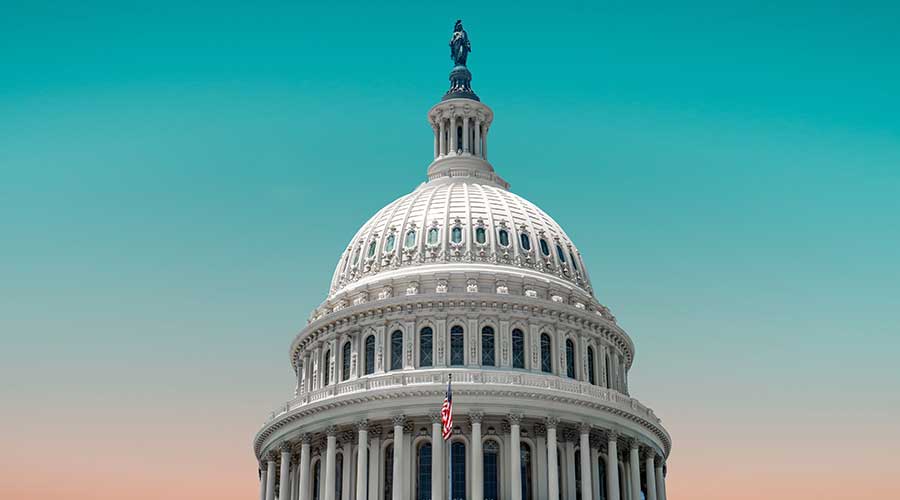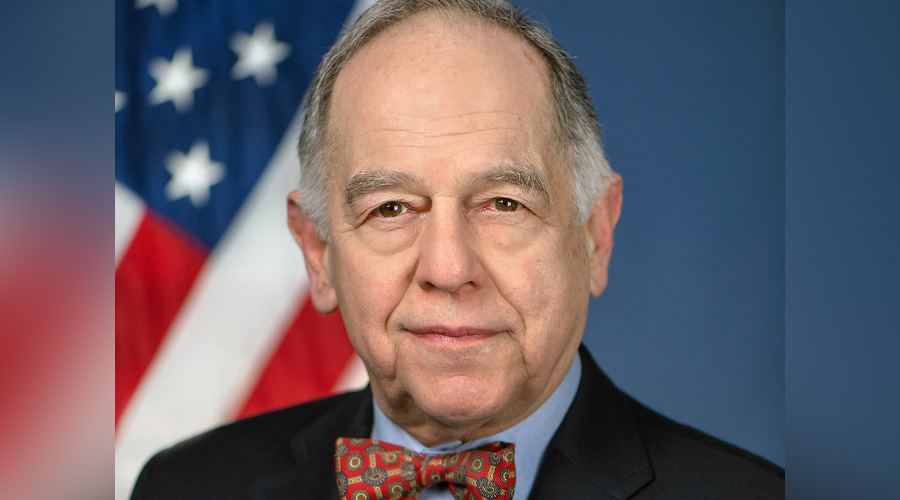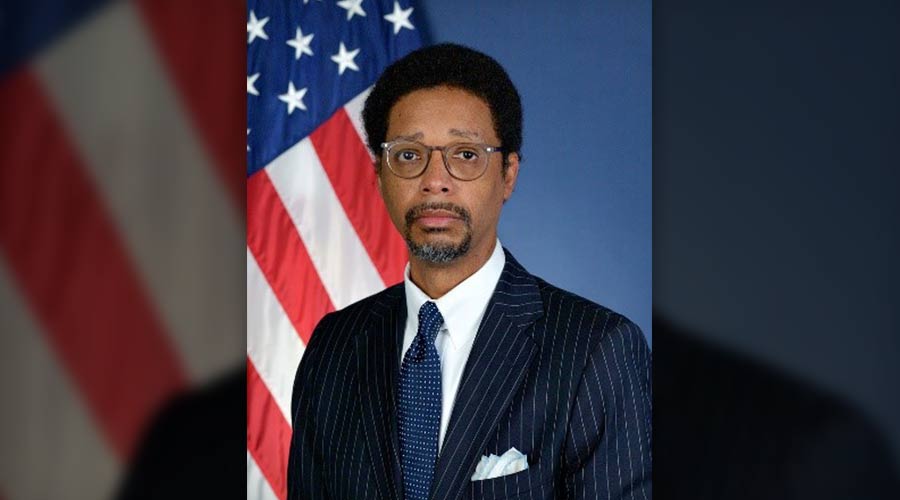Stay updated on news, articles and information for the rail industry
February 2017
Rail News: Federal Legislation & Regulation
Rail advocates encouraged by Trump's emphasis on regulatory reform, infrastructure

— By Julie Sneider, Senior Associate Editor
For rail industry lobbyists and trade associations, many of the legislative issues in the 115th Congress are carryovers from the 114th Congress: federal funding, a pro-business regulatory environment, tax reform and fair trade policies.
One major and obvious change, however, is how those issues will fit in with whatever transportation policy is developed under President Donald Trump.
Many association representatives who spoke with Progressive Railroading prior to the Jan. 20 inauguration and during the early days of the new Congress noted that while details on the future of federal transportation policy remained few and far between, they were optimistic about the days ahead. That optimism was due primarily to Trump’s promise to produce a pro-business regulatory environment as well as a massive — if not rail-specific — plan to beef up the nation’s ailing transportation infrastructure. Both are concepts that rail advocates say they can get behind.
Prior to and since the November 2016 elections, Association of American Railroads (AAR) President and Chief Executive Officer Ed Hamberger has called on Congress and the new administration to rescind proposed regulations that the association believes would undermine the freight-rail industry if approved.
For example, in a December 2016 "Outlook 2017" column for ProgressiveRailroading.com, Hamberger noted that the proposed "reciprocal" or "competitive switching" rule amounts to re-regulation. Proposed by the Surface Transportation Board (STB), the rule would "force carriers to turn their traffic over to competitor railroads, which would significantly compromise network efficiency, and in turn reduce investments" in railroad infrastructure, Hamberger wrote.
Reciprocal switching refers to a situation in which a railroad that has physical access to a specific shipper facility switches rail traffic to the facility for another railroad that does not have physical access. In 2011, the National Industrial Transportation League asked the STB to modify its competitive switching standards to allow certain captive shippers located in terminal areas to be granted access to nearby competing railroads.
In October 2016, the STB proposed a rule that would allow shippers to switch cargo among large railroads if shippers can show the arrangements are "practicable and in the public interest" or "necessary to provide competitive rail service."
Tried-and-true priorities
Several rail suppliers and associations also have expressed concern about proposed STB measures they view as re-regulation. In October, a group of suppliers wrote to members of Congress to object to reciprocal switching and proposed rules that would regulate certain commodities. The letter was signed by GoRail, the National Railroad Construction and Maintenance Association (NRC), the Railway Engineering-Maintenance Suppliers Association, the Railway Supply Institute (RSI), Railway Systems Suppliers Inc. and the Railway Tie Association, as well as 106 individual suppliers.
"There are the tried-and-true traditional rail-industry priorities, most of which are still relevant and which we intend to focus on more than ever," says NRC President Chuck Baker. "On the freight-rail side, there’s the need to have a balanced and reasonable economic regulatory environment. And toward the end of 2016, there were some very worrisome potential rules being discussed at the STB."
Baker believes the STB's consideration of the proposed rules will be "on hold" until President Trump fills two vacant seats on the board, which was expanded from three to five members under the STB Reauthorization Act of 2015 but has continued to operate as a three-member panel. The current STB members are Daniel Elliott III, Deb Miller and Ann Begeman. On Jan. 25, Trump named Begeman — a Republican — acting chairman to succeed Elliott, a Democrat appointed by President Barack Obama.
"We'll be aggressively making our case to the new board and commissioner that the regulations would be counterproductive for the rail industry and the economy," Baker adds.
In December, the AAR asked that the STB refrain from making any decisions on the controversial regs until after Trump makes his board appointments. Moreover, AAR joined several associations and chambers of commerce to encourage House Speaker Paul Ryan (R-Wis.) to make the "Regulatory Accountability Act" an early priority. The proposed law would require agencies to gather data, evaluate alternatives and solicit public opinions on the cost and benefits of government rules and regulations before they’re implemented. AAR voiced a similar plea in an early January letter to Vice President Mike Pence.
"We believe policymakers should ensure that rules are based on current and complete data and sound science; regulations are enacted only if benefits outweigh costs and agencies analyze the cumulative effects of proposed regulations; and 'guidance' and 'emergency orders' are limited as regulatory tools," Hamberger said in a prepared statement.
On the regulatory reform front, the new administration appears to concur with the freight-rail industry’s viewpoint. On his first Monday in office, Trump told a gathering of chief executives that his administration would be cutting regulations "massively" — by 75 percent or "maybe more."
Besides proposed regulations pending at the STB, other regulatory issues of concern to the industry include the U.S. Department of Transportation’s call for mandatory installation of electronically controlled pneumatic (ECP) brakes on certain trains carrying flammable liquids, and the Federal Railroad Administration’s (FRA) proposed rule requiring a minimum of two-person crews on freight trains. Last month, U.S. Rep. Don Young (R-Alaska) reintroduced legislation that would require a minimum of two crew members on all freight trains.
Endorsed by rail labor organizations such as the SMART Transportation Division and the Brotherhood of Locomotive Engineers and Trainmen, a mandate for two-person crews is opposed by AAR, the American Short Line Regional Railroad Association (ASLRRA) and NRC.
"The two-man crew mandate makes no sense in a world of increasing automation, especially when we’re talking about railroads having to compete with autonomous trucks," says NRC's Baker.
Regarding the brake mandate, the AAR has argued that less than 1 percent of all train accidents are related to failed brakes, and that USDOT has not produced enough data indicating that brake technology would improve safety.
Truck-size debate
Another topic of concern to freight-rail advocates is the trucking industry's dogged lobbying for new federal standards that would allow for longer and heavier trucks on U.S. roadways. A two-year USDOT study on the impact of bigger trucks on highways didn't recommend whether current policy should be changed.
Previously proposed bills have sought to allow states to raise truck weight limits from 80,000 pounds to 97,000 pounds, as well as permit double- and triple-trailer trucks to travel over longer distances. Although the issue has major implications for Class Is — namely, that more freight would be moved by trucks that aren’t contributing heavily to the upkeep cost of U.S. freeways — it also affects short lines that interchange with Class Is. AAR, ASLRRA and other freight-rail proponents cite safety concerns, as well.
"We care not only about the heavier trucks but longer trucks," says Nicole Brewin, RSI's vice president of government affairs. "We fought that last year and we’re gearing up to deal with that again this year."
Another of the "tried-and-true" issues that will be back on the policy agenda is the 45G tax credit, which provides short lines and regionals a 50-cent tax credit for each dollar they spend on track rehabilitation and maintenance up to $3,500 per mile of track owned or leased by the railroad.
In December 2015, Congress passed the fifth short-term extension of the credit, extending it through 2016. ASLRRA lobbied for support of the Building Rail Access for Customers and the Economy (BRACE) Act, a bipartisan bill introduced last year that would have made the tax credit permanent. But because there was no major tax reform legislation to attach the BRACE Act to, the bill didn't pass and the credit expired at 2016's end.
Nevertheless, the BRACE Act was reintroduced in Congress on Jan. 30. Its passage will be ASLRRA’s primary legislative issue this year, said association President Linda Bauer Darr in an email.
"The short lines have a great story to tell — we fill a critical role in America's transportation network, promoting industrial development and serving customers in 49 states that would otherwise be disconnected from the national rail network," she said. "Critical to our success is the ability to self-fund our capital-intensive industry, which is in part achieved by the 45G tax credit."
Other associations also have the tax credit issue at the top of their policy agendas.
"We'll support the ASLRRA on this issue as we have in the past," says Baker. "We'd like the solution to be that the tax credit becomes permanent so that we don’t have to do this routine every two years. That's a priority. There will be more clarity on it when tax reform is discussed in Congress."
Probably the biggest unknown regarding transportation this year is what Trump's specific plan on infrastructure will entail. During the campaign, both he and Democratic presidential nominee Hillary Clinton pledged that if elected they’d pursue major investments in rebuilding roads, bridges, seaports, airports and railways.
Although Trump has yet to reveal details, he has hinted the package could be worth up to $1 trillion, though some GOP members in Congress are likely to balk at such a high price tag.
One potential way to appease the deficit hawks would be a bill that emphasizes private investment in infrastructure through tax credits and public-private partnerships — as opposed to direct federal investment. The private investment route is one that Trump reportedly was considering as of press time.
And while Trump initially said he would have an infrastructure plan on the table during his first 100 days in office, members of Congress and rail lobbyists say they don’t expect to see anything until spring, at the earliest. In the interim, Congress will work on funding, House Transportation and Infrastructure Committee Chairman Bill Shuster (R-Pa.) told The Hill in early January.
"We're going to start to work on it, but first of all, you've got to figure out the pay-fors, which will come, I believe, in the first 100 days," Shuster said in the article. "Then, in the next second 100 days is when we'll put together a big infrastructure package."
On Jan. 24, Trump did take some action on infrastructure by signing an executive order to streamline the environmental review of critical infrastructure projects, a move that will help speed up the process once those projects are in the pipeline, Shuster said in a prepared statement. AAR's Hamberger also endorsed Trump's executive order, noting that "we also know too well how time consuming, costly and, at times, redundant it can be to fully implement an infrastructure project."
Meanwhile, also on Jan. 24, Senate Democrats rolled out their own version of a $1 trillion plan for infrastructure and transportation projects, including $180 billion for rail and bus systems. Senate Majority Leader Mitch McConnell (R-Ky.) quickly dismissed the Democrat’s plan as too much like Obama's federal stimulus bill, while Senate Minority Leader Charles Schumer (D-N.Y.) said the Democrats won’t support a package that features tax breaks for infrastructure developers.
Encouraging sign
Still, rail groups say they're encouraged by Trump’s promise to shore up and modernize U.S. transportation infrastructure. Regardless of when the president is ready to unfurl his plan, they’ll be ready for it and expect rail to be included, they say.
Several rail associations already have endorsed Trump's selection of Elaine Chao as U.S. transportation secretary, a seasoned Capitol Hill insider who they expect will be helpful in garnering congressional support for the president’s plan. During her Senate confirmation hearing, Chao — who served as labor secretary under President George W. Bush and deputy secretary of transportation under President George H. W. Bush — talked about the need to streamline government bureaucracy in infrastructure projects, “unleash the potential” of private investment in transportation, and explore new technologies that will make transportation safer and more efficient.
However, a package that includes direct federal investment — and not just leveraging private-sector dollars — will be necessary to boost passenger-rail systems, including funds to help them meet their state-of-good repair backlog, transit-rail officials say.
The National Association of Railroad Passengers (NARP) will have a list of "shovel-ready" passenger-rail projects to recommend when Congress takes up infrastructure, says President Jim Mathews.
Mathews believes "historic progress" has been made in recent years to secure bipartisan support for passenger-rail service in urban as well as rural communities. He notes that the five-year Fixing America's Surface Transportation (FAST) Act of 2015 was a "huge win" for rail advocates because it contained a practical, bipartisan plan to ramp up investment.
"As I look to the future in the new Congress, there's an emerging consensus on the need for rail as a nonpartisan issue," says Mathews. "We are looking to build on that this year."
One specific topic that NARP will focus on is a permanent funding mechanism.
"What we desperately need and will ask Congress for is a sustainable source of funding, and that’s especially true for passenger rail," Mathews says.
American Public Transportation Association (APTA) officials also are encouraged by Trump’s ongoing emphasis on infrastructure investment, and the association is drafting its policy priorities for major legislation that may be introduced.
"The stage is set in a positive way to do something big on infrastructure," says Andrew Brady, APTA’s senior director of government affairs. "There are a lot of different ideas floating out there. But public transportation needs to be a part of it, so we’re preparing to make that case."
Congress is still operating under a continuing resolution, which expires in April, Brady notes. But once the full appropriations process begins to fund federal programs, APTA will be advocating for money approved under the FAST Act to help transit-rail agencies pay for positive train control (PTC) implementation.
"Our member commuter railroads are committed to meeting the PTC deadline, so that item is high on our legislative agenda," says Brady.
RSI also supports long-term dedicated funding for transit-rail.
"Our members and the rail industry would strongly benefit from increased investments in infrastructure upgrades and safety improvements," says Brewin.
Likewise, NRC's members would benefit from a legislative package that promotes rail projects and the contracts that would result, says Baker. To help ensure rail contractors will benefit from such investment, NRC will be calling on Congress and the Trump administration to find ways to encourage transit agencies that accept funding for state-of-good repair projects to competitively bid the work to contractors, Baker says.
Such efforts would help ensure publicly funded projects are completed in a more cost-efficient manner, he adds.
Public support for transit
Regardless of when Trump's infrastructure plan is introduced, rail advocates believe it will address public transit.
APTA's Brady is convinced Congress is paying attention to growing public support for transit, which has been demonstrated in part by the number of recent voter-approved ballot initiatives that call for raising local taxes to fund construction or expansion of light rail, commuter rail, subways and streetcar lines.
"They're definitely noticing," Brady says. "I think it's interesting that, often times, the folks in Washington are led by the folks back home. There was a huge number of ballot measures that passed last November, which shows bipartisan support for rail as a passenger mobility mode."
Email comments or questions to julie.sneider@tradepress.com.


 LRW Honors Amtrak’s Acheson As Railway Woman Of The Year
LRW Honors Amtrak’s Acheson As Railway Woman Of The Year
 From Editor-In-Chief Foran: Of Gender Equity And Inclusion
From Editor-In-Chief Foran: Of Gender Equity And Inclusion
 Spotlight On Some Of Today’s Rail Safety Products
Spotlight On Some Of Today’s Rail Safety Products
 Women of Influence in Rail eBook
Women of Influence in Rail eBook
 railPrime
railPrime







